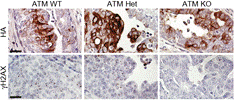Veterinary and Biomedical Sciences, Department of
Document Type
Article
Date of this Version
2009
Citation
Antiviral Research (2009) 82: A24-A25. DOI: 10.1016/j.antiviral.2009.02.037.
Abstract
Bovine leukemia virus (BLV) is an oncogenic retrovirus that infects cattle. It is classified in the human T-cell leukemia virus (HTLV) group, although BLV mainly infects B cells rather than T cells. Most BLV-infected cattle remain asymptomatic, but about 30% develop persistent lymphocytosis, and perhaps 5% eventually acquire B-cell lymphoma. Mainly as a result of the latter condition, BLV is a significant economic problem for cattle producers worldwide. Moreover, because of the close genetic similarities between the two viruses, BLV may also be a useful model for investigating HTLV-associated diseases in humans. The prognosis of HTLV-I-associated disease is generally poor because of resistance to chemotherapy. Clinical trials using antiretroviral agents to treat HTLV-I-infected patients have been generally unsuccessful; there is clearly a need for additional therapies.
We are currently using an in vitro BLV infection assay as a model to screen various compounds for antiviral activity. Persistently BLV-infected fetal lamb kidney (FLK) cells are used as a source for infection of other cell types. For example, feline CC81 cells form multinucleated syncytia upon exposure to FLK-BLV cells. The formation of syncytia can be quantitated to reflect the levels of infection. We recently found that the BLV-induced syncytium formation can be inhibited by ribavirin or alpha interferon, but a combination of ribavirin and alpha interferon at doses similar to those used to treat human hepatitis C virus infection are much more effective. No cytotoxic effects were observed at the effective doses, and this inhibition is greater than that achievable with either drug separately. We are currently refining our infection assay as well as testing additional compounds. Furthermore, we are developing additional methods to quantitate the production of BLV antigen, as well as the expression of BLV-specific mRNA, to corroborate these results.



Comments
Copyright 2009, Elsevier. Used by permission.